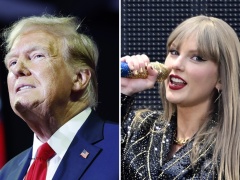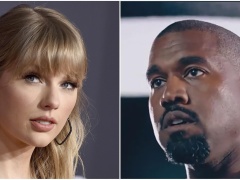
Lil Nas X isn’t here to win over folks who think homosexuality is the devil’s work. In his new video for “Montero (Call Me By Your Name),” the 21-year-old rapper makes out with Satan (albeit a CGI one), lap dances on him and twerks all over his face. If just reading that description fills your head with visions of blasphemy, cover your eyes. For the next few months, “Montero,” which is quite possibly the biggest and brightest explosion of gay pride ever to call itself a music video, will probably be everywhere. Just three days after its March 26 debut, it already logged 40 million YouTube views.
It’s the next phase of a career that’s been all about pushing boundaries from the start. Lil Nas X’s breakthrough single, “Old Town Road,” blended the previously disparate-seeming genres of rap and country and ended up becoming the longest-running No. 1 single in chart history. about halfway through its chart-topping run in 2019, on the last day of Gay Pride Month, Nas came out as gay.
Now he is bulldozing queerness farther from the closet than any Grammy-winning, multiplatinum, openly gay pop star has ever dared. “Montero,” which borrows its subtitle from the Oscar-nominated 2017 film, revels in the joy of queerness, a rarity in a medium whose recent LGBTQ videos have focused more on the serious and the tragic, while brazenly flaunting gay sexual liberation. It takes a brave gay man to slide down a stripper pole to hell, seduce the devil, kiss him, kill him and assume his throne. Lil Nas X will make swarms of pearl-clutchers enraged, but he’s already made history.
How far we’ve come from the days when only straight music stars could tease us with glimpses of overt LGBTQ sexuality in their videos without killing their careers. Although straight glam rockers like David Bowie (who was kissed on the lips by an overzealous male fan in his 1979 “D.J.” video) and Marc Bolan and disco titans like Sylvester and Village People made ‘70s music safe for LGBTQ sensibilities, by the early ‘80s, those sensibilities were being pushed back into the closet.
Openly gay acts like Boy George and Pet Shop Boys were thriving, but they played it relatively safe. Boy George introduced a large swath of the masses to gender-bending drag, but his videos with Culture Club, like most Pet Shop Boys clips, were sexless affairs. If queer acts hinted at homoeroticism (as Pet Shop Boys did with their 1988 clip for “Domino Dancing,” the duo’s final Top 40 hit), it was typically done within the context of straight relationships and with a considerable dose of camp and humor.
That’s certainly what drove the video for Olivia Newton-John’s 1981 smash “Physical.” The song was a culmination of the sexy image the former sweet country girl had been cultivating since the 1978 movie musical “Grease,” and the video, which dropped during the early days of MTV, was one of the first to dabble with LGBTQ images. You had to stay until the very end, though, for the gay punchline. The hunks Newton-John was eyeing in the gym only had eyes — and arms — for each other. The song was banned and MTV cut the gay ending, but the single still became the biggest hit of the decade.
Queen took the camp up a notch with 1984’s “I Want to Break Free,” which put the entire band (including a still-closeted Freddie Mercury) in drag a full 25 years before “RuPaul’s Drag Race” made it mainstream-fashionable.
While most LGBTQ ’80s acts were playing it safe musically and publicly, Frankie Goes to Hollywood released “Relax” in 1983. The video featured the band’s openly gay frontman Holly Johnson performing in a gay S&M club (camp strikes again), and both the song and the clip were promptly banned by the BBC. The following year, Bronski Beat’s “Smalltown Boy” became arguably the gay anthem of the decade, largely based on a video narrative that took viewers on the painful, confusing, exhilarating journey of coming out.
The ’80s was a tragic era for the gay community, and by the end of the decade, the stigma of AIDS had pushed a lot of LGBTQ talent into the shadows. The biggest acts waving rainbow flags with their careers intact were primarily straight. Madonna, one of the gay community’s strongest allies, kicked off her ’90s reign paying homage to ’80s gay ball culture with “Vogue” and making out with a woman in “Justify My Love” (1990). She scored two more No. 1 hits in the process.
Three years later, alternative rock got into the act with Living Colour’s “Bi,” a celebration of bisexuality with a video that presented it through the straight male gaze (translation: a focus on bisexual women, aka a straight guy’s fantasy) and perhaps paved a path for more open LGBTQ acceptance in the genre. Red Hot Chilli Peppers’ 1995 video for “Warped” even featured lead singer Anthony Kiedis and then-guitarist Dave Navarro kissing at the end.
Despite the commercial obstacles they faced, some female LGBTQ performers, like Indigo Girls, k.d. lang and Melissa Etheridge, opened doors by busting them down in the ’90s. We’d have to wait until the following decades for lesbianism to fully flourish in music videos, though, and until recent years, when superstar acts were involved, they were often straight (as with Madonna kissing both Britney Spears and Christina Aguilera onstage at the 2003 MTV Video Music Awards). Etheridge scored her first and only Top 10 pop hit with “I’m the only One” in 1993, and the performance video featured women in the audience kissing and caressing each other while Etheridge remained onstage in the chaste zone.
Five years later, in 1998, George Michael, who recently had been forced out of the closet after being arrested for soliciting a male undercover cop, released his coming-out video, “Outside,” which celebrated the joy of hooking up in public while poking fun of his arrest. Like Etheridge, Michael was the only one in the video who didn’t get lucky.
By the 2000s, the list of straight artists affirming their allyship with the LGBTQ community was growing. “Beautiful,” Christina Aguilera’s 2002 underdog empowerment anthem, prominently featured a gay couple, and in the years that followed, leading ladies of pop continued leading the way with their videos, including Kylie Minogue’s “All the Lovers,” Pink’s “Raise Your Glass,” Rihanna’s “Te Amo,” Carly Rae Jepsen’s “Call Me Maybe,” Demi Lovato’s “Really Don’t Care,” Jennifer Hudson’s “I Still Love You” and Ariana Grande’s “Break Up with Your Girlfriend, I’m Bored.”
Across the pond, straight male artists were showing their solidarity, too. The Libertines’ frontman Pete Doherty made a soccer-themed video for “Last of the English Roses,” his 2009 debut solo single, that featured two young men kissing tenderly at the end. The next year, Take That members Robbie Williams and Gary Barlow walked into the sunset and lived happily ever after at the end of “Shame,” a No. 2 UK hit, and in 2013, Irish singer-songwriter Hozier scored a massive U.S. hit with “Take Me to Church,” a song whose video told a gay love story with a tragic end.
The 2010s was the dawning of a new era of visibility for LGBTQ themes and LGBTQ artists in music videos. “Same Love,” Macklemore and Ryan Lewis’s 2012 song of the year Grammy nominee, featured the lesbian singer Mary Lambert on vocals, and is perhaps best known for its video, which spanned a decades-long gay love story and supported marriage equality three years before it became law.
By mid-decade, Sam Smith had launched their pop ascent as an openly queer blue-eyed soul singer, and the video for their 2015 Top 10 hit “Lay Me Down” featured the Grammy and Oscar winner in a tear-jerker of a gay storyline. Smith was the most commercially successful of the increasingly expanding circle of openly LGBTQ acts that rose to prominence in the 2010s, and although many had to settle for critical acclaim and industry buzz over chart hits, they often used their videos to improve LGBTQ awareness. Art-pop stylist Perfume Genius has released a string of videos exploring modern queerness; country singer Steve Grande fell in love with a boy in 2013’s “All-American Boy” and went viral; and Australian singer-songwriter Troye Sivan paid homage to gay activism, gay love and Harvey Milk with his 2016 clip “Heaven.”
Lately, more LGBTQ ladies have been getting in on the action. Transgender German singer-songwriter Kim Petras played up her sex appeal (and got the guy) in 2018’s “Heart to Break.” Hayley Kiyoko has amassed a massive YouTube following with a string of videos that explore lesbian relationships in various stages, including “What I Need,” her 2018 collaboration with bisexual singer Kehlani. On her own, Kehlani racked up 43 million YouTube views with “Nights Like This,” a 2019 cyborg queer fantasy with shades of the 2017 best picture Oscar winner “The Shape of Water.”
The ladies are pushing boundaries by being themselves, but Lil Nas X is taking bigger risks in hip-hop, a traditionally homophobic genre that has only recently begun opening its doors to LGBTQ talent. By assuming the role of hellraiser in “Montero,” Nas X has raised both the bar and the stakes. He danced with the devil (literally) and came out on top. That’s going to be a hard act to follow.






